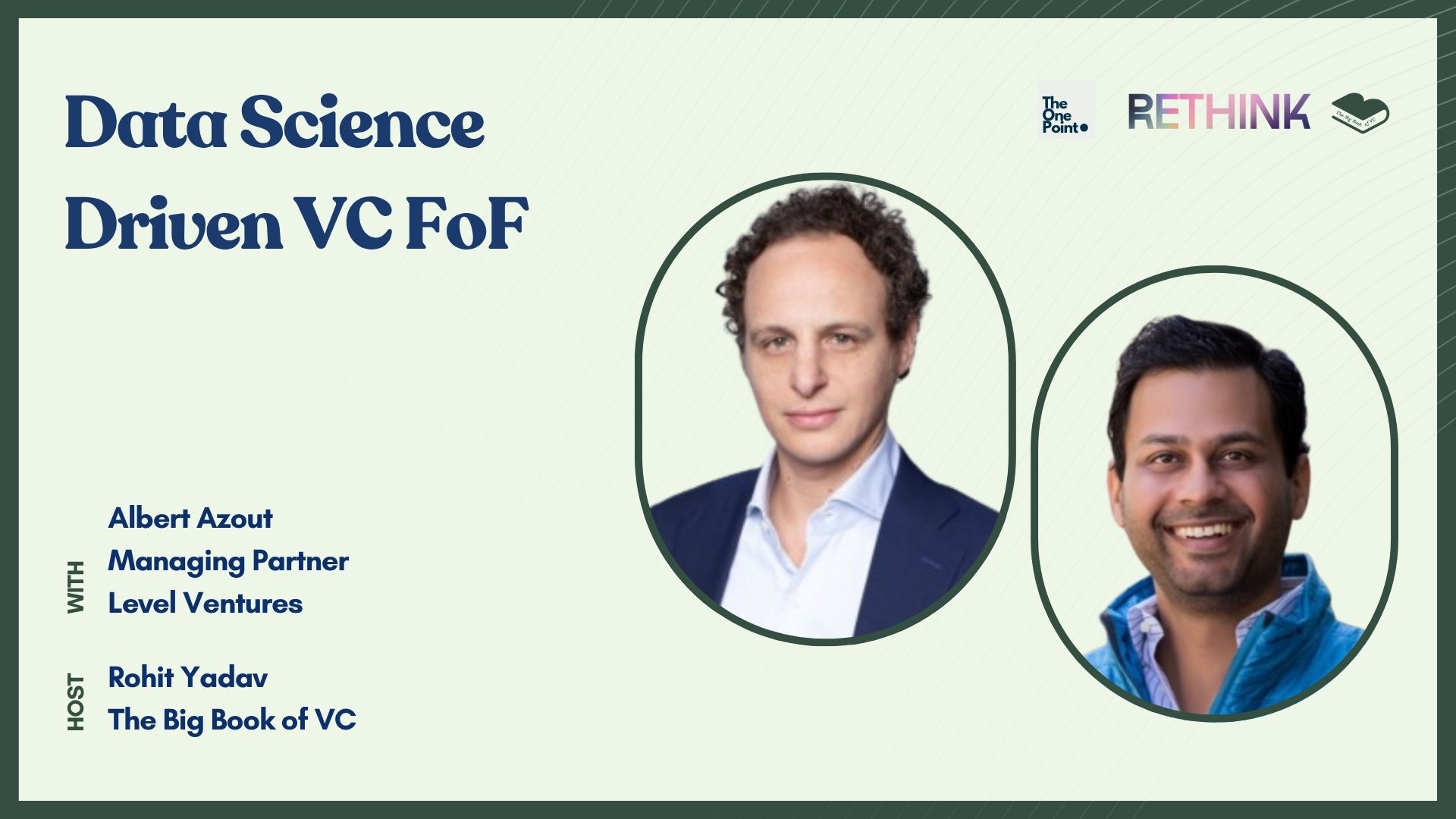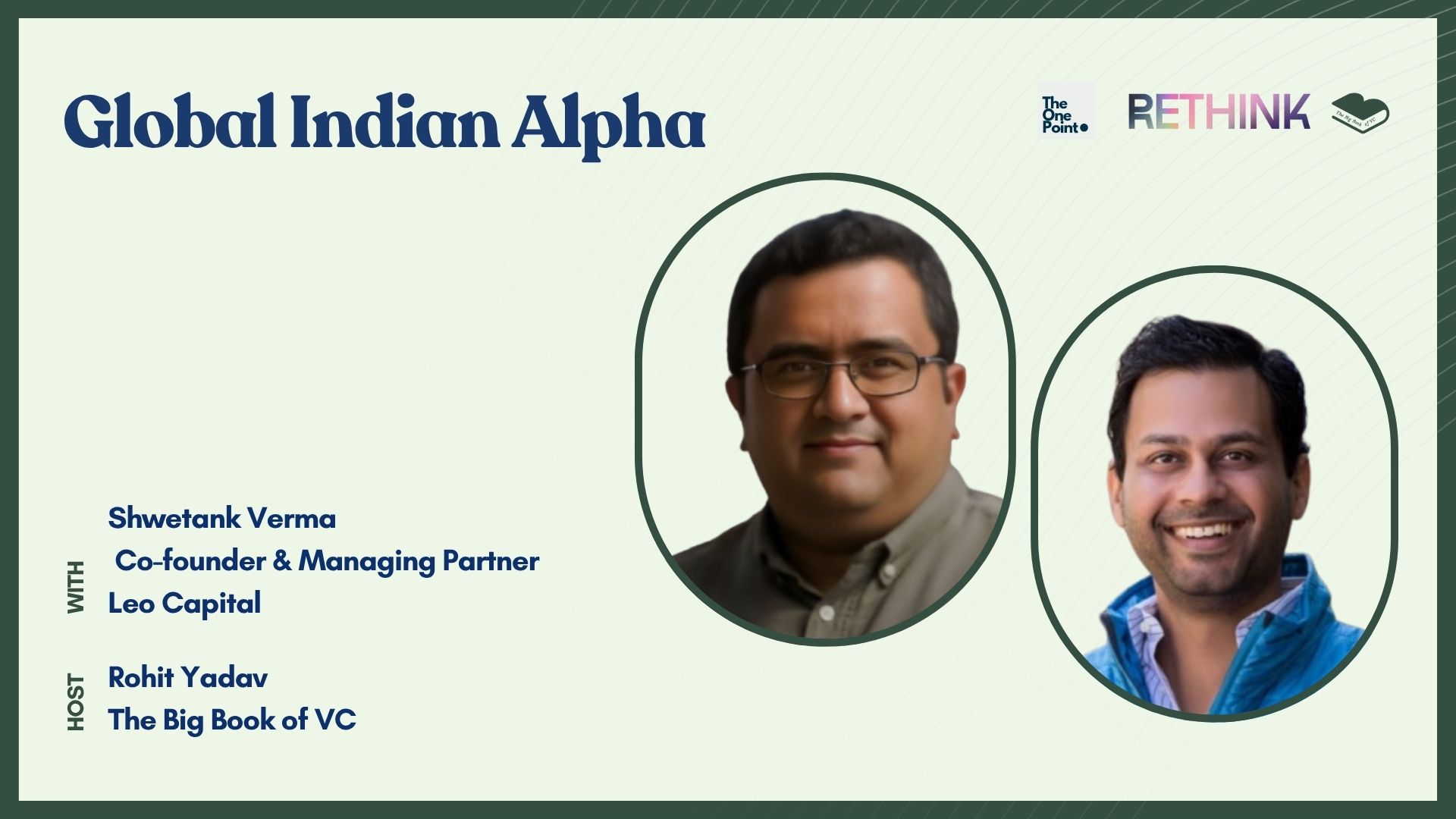Indexing Venture
Snapshot of the interview with Rob Hodgkinson from SignalRank
Rohit Yadav: Welcome to TheOnePoint podcast. I’m Rohit Yadav. In our recent report Rethinking Venture Capital, we explored “Venture 3.0” as a system-level transformation. Today, we're diving into a narrower but crucial topic—algorithms and AI in venture capital—with a leader in this space: Rob Hodgkinson, Managing Director at SignalRank. Rob, thanks for being here.
Rob Hodgkinson: Thanks for having me, Rohit. Congrats on the report—it’s a phenomenal read.
Rohit: Thank you, Rob. Let’s start at the top. What is SignalRank?
Rob: SignalRank is essentially an index of the top 5% of Series B investments. We use a systematic, data-driven method to identify these companies and access them via the pro-rata rights of existing seed investors. Think of it as the S&P 500 of venture capital—our mission is to democratize access and use data to invest more intelligently in VC.
Rohit: Where did the idea for SignalRank come from?
Rob: I was a VC in London 10–15 years ago and always found it ironic that VCs believed data would transform every industry—except their own. At that time, the data just wasn’t mature enough to build anything scalable. Later, I ran a video startup in Europe and faced firsthand how tough it was to raise a Series B round there. That startup was acquired in 2019, and in 2020, I moved to the U.S. to solve this problem—bringing U.S. capital into European Series Bs by partnering with seed investors. But that model didn’t scale.
Then I met Keith Teare, who had already developed a data-led strategy for identifying top Series B rounds. I joined forces with him and we built SignalRank.
Rohit: How exactly does your model work? You’re not looking at companies themselves?
Rob: Right. We exclusively analyze investor patterns, not company fundamentals. We believe there's persistence in venture capital: good investors continue to get access to great deals. So, we rank investors at every stage—A, B, C—based on unicorn efficiency, hit rate, and MOIC over a rolling three-year window. From there, we identify powerful patterns when top-tier investors double down across rounds. That gives us a "company score" with high predictive power.
Rohit: So essentially, you're betting on the investors, not the companies?
Rob: Exactly. We're standing on the shoulders of giants. It’s unusual in venture, but not in finance. The first hedge fund by Alfred Winslow Jones worked similarly, scoring brokers based on performance. Marshall Wace, Europe’s biggest hedge fund, uses the TOPS program to rank broker recommendations—again, similar to what we do by ranking VCs.
Rohit: There’s some debate in the VC world about network effects. Do you agree with PitchBook’s emphasis on network centrality?
Rob: I do. The most compelling stat from PitchBook was that well-networked investors not only support upside but also reduce downside risk. Our algorithm is actually more about filtering out zeros—it’s highly effective at avoiding companies that go to zero. Then we randomly sample from the filtered pool. In Monte Carlo simulations, that portfolio significantly outperforms the average VC—5x in five years.
Rohit: Why focus only on Series B? And how does geography factor into your model?
Rob: We like Series B for four reasons. First, you can create a risk-adjusted portfolio with just ~30 investments a year. Second, the power law is still early at Series B, so you can still hit 25–100x outcomes. Third, you're insulated from IPO risk—Series B investors often make money even if the IPO underperforms. Lastly, most seed investors are tapped out by Series B, so it’s the perfect point for us to step in.
As for geography, we are truly global and sector-agnostic. We’re like an index—trying to see all Series Bs and let the algorithm pick the top 5%. Currently, we see around 60% of all Series B deals globally and 25–30% of the top qualifiers.
Rohit: And you’re already one of the most active Series B investors?
Rob: Yes, we’ve made 35 investments in two years. Apart from Andreessen Horowitz, we’re the most active Series B investor globally by number of investments. In 2025 alone, we’ve co-invested in five Sequoia-backed Series Bs.
Rohit: You recently published your two-year investing update. Why call this an index?
Rob: It’s not an index in the strict sense—we’re sampling from the top 5% of Series Bs. But from an investor perspective, it behaves like an index. Most LPs can’t get into Sequoia or Andreessen. We let them mirror those portfolios by investing alongside them. Ultimately, our goal is to list SignalRank so anyone can buy a share and instantly get exposure—along with vintage diversification, which you don’t get with traditional 2-and-20 funds.
Rohit: That’s fascinating. Now let’s talk about your seed investor network. Why do they partner with you?
Rob: Two reasons: First, we offer 20% deal-by-deal carry. If we make $9M profit on a $1M investment, we write the seed investor a check for $1.8M. Second, we move fast—closing in under a week. Most seed investors don’t have opportunity funds, so they can’t double down. We let them do that with no friction. It’s like offering pro-rata as a service.
Rohit: If this area is so compelling, why aren’t there more firms like SignalRank?
Rob: There are a few, like Alpha Partners and Proof, but we’re unique because the algorithm makes the investment decisions. We don’t override it based on gut feeling or personal conviction. That’s unusual in VC. If we don’t trust the algorithm, why would we ask our investors to?
Rohit: Zooming out, where do you see the biggest opportunity for AI in VC, outside of your own model?
Rob: I think seed investing will remain artisanal—it's about reading people, not data. But later-stage investing is starting to resemble public markets. Index investing dominates public markets now, and I expect the same in venture. If firms like Sequoia and Andreessen can consistently deliver alpha, they may even move beyond 2-and-20 fees.
Rohit: What about specific AI use cases like sourcing or portfolio management?
Rob: Some firms are building or buying tools for that. But VC’s core product is the decision-making engine. If AI can improve that, it will be adopted. If not, it’ll remain a side tool. That said, communities like Andre Retterath’s Data-Driven VC are doing great work pushing best practices in this space.
Rohit: Should traditional VCs be worried about AI?
Rob: Not at all. As you wrote in your report, venture is no longer monolithic. At early stages, I see little role for AI. But at later stages, if you’re not investing in data and AI tools, you’ll be left behind.
Rohit: Switching gears—how’s your journey been personally leading SignalRank?
Rob: On the investing side, our thesis has played out well. We’ve built thresholding mechanisms to adapt with the market. When the market is hot, we invest less, and vice versa. On the fundraising side, it's been harder—especially trying to innovate when venture is out of favor. But I believe what we’re doing is inevitable.
Look at what BlackRock, Preqin, StepStone, and Coatue are doing—it’s all about democratizing access to venture. We're just early players in that larger trend.
Rohit: What’s next for SignalRank?
Rob: We want to scale up our capital so we can write full $5M checks per Series B. We’re currently investing in 2–3 Series Bs a month. Our long-term goal is to list SignalRank so people can get liquidity anytime. You buy a share and get instant access to a diversified, high-quality venture portfolio.
Rohit: Rob, thank you so much. I truly believe there’s a big space for what you’re doing—it may not be for the entire industry, but it's definitely inevitable.
Rob: Thanks for having me, Rohit. I’ve really enjoyed this.



.svg)




